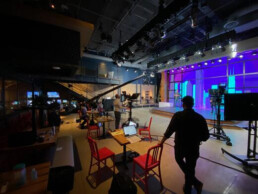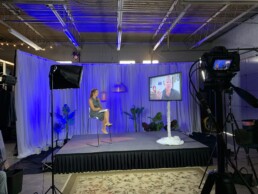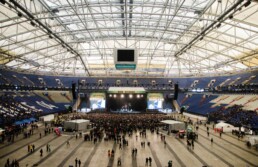10 Event and Meeting Trends Shaping 2024
Embark on a journey into the future of event planning as we unveil the top 10 trends shaping 2024. From eco-conscious gatherings to cutting-edge technology, this guide is your passport to staying ahead in the dynamic landscape of event management. Join us in exploring the keys to unlocking unforgettable events in the coming year, where sustainability meets innovation, and tech-forward experiences take center stage!
Sustainable Events Take Center Stage
Embrace eco-friendly events with a focus on economic and climate concerns, promoting sustainable behavior and responsible resource sourcing. Read more about sustainable events HERE.
Privacy & Security in the Digital Sphere
Prioritize data security in the digital age, intensifying privacy regulations, and training for handling sensitive attendee information.
AI's Evolution in Event Planning
Dive into AI-powered recommendation engines and engaging headlines for personalized attendee experiences.
Digital Accessibility for All Events
Ensure inclusivity with technology, integrating screen readers and voice recognition tools for accessible digital and in-person events.
Social Media: The Event Promoter's Ally
Leverage platforms like Facebook and LinkedIn for event promotion, forming partnerships with digital influencers for expanded reach.
Live Streaming Dominates Engagement
Ride the wave of live streaming events, attracting millennials and Gen Z through partnerships with digital influencers.
Mobile Technology Transforms Event Experience
Embrace the mobile revolution with event-focused apps, providing seamless event discovery, reservations, and ticket purchases.
Augmented & Virtual Reality Redefine Experiences
Explore Augmented Reality (AR) for enhanced customer service and Virtual Reality (VR) for immersive event experiences.
Data's Growing Role in Event Planning
Invest in data analytics tools, using insights to track attendee behavior and make informed decisions for future events.
The Future of Hybrid and Virtual Events
Continue the trend of virtual and hybrid events for global accessibility and cost-effectiveness, providing broader reach and engagement.
How AV Chicago can take the stress out of hosting an online or hybrid event
Safety is still at utmost importance as we continue to work from home and take precautions around events and social gatherings. As the vaccine numbers increase steadily, meeting and event professionals are gearing up for hosting in-person and hybrid events to bring people back together safely. Luckily, AV Chicago and partner Chop Shop have found a way to take the stress out of planning hybrid and online events. With an expert team and a state of the art facility, any planner should feel comfortable enough to explore the possibilities of hosting a hybrid event.
In order to keep engagement after so much technology fatigue, a new hybrid approach may be your best option to keep attendees engaged. Not only will a hybrid event help create an exceptional experience for all your attendees no matter where they are participating, but it will also take care of your in-person hospitality needs as well. President of AV Chicago, Andrew Brode notes
“The studio will be a great asset to our client’s upcoming virtual and hybrid events. We have built a space that looks as spectacular in person as it does virtually. Coupled with our production skills and event platform, we continue to elevate what a virtual event should be.â€
- Andrew Brode, President, AV Chicago
Meeting and event planners are looking for ways to make their upcoming events stronger by using high-end production work including professional video, audio, and lighting. To produce quality online events, you need to find a good partner that can not only handle the technical aspects but also provide a scenic space that will look great on camera and in person. With only a few studios in the Chicagoland area set up for these types of events, AV Chicago’s Chop Shop studio is the premier partner for any hybrid or virtual event.
Make it easier on yourself for your next event, and create your most engaging presentation yet! To learn more about AV Chicago’s Chop Shop Studio, visit AV Chicago.
Written by: Natalie Kokaska
What You Need to Know About #HTSOnline
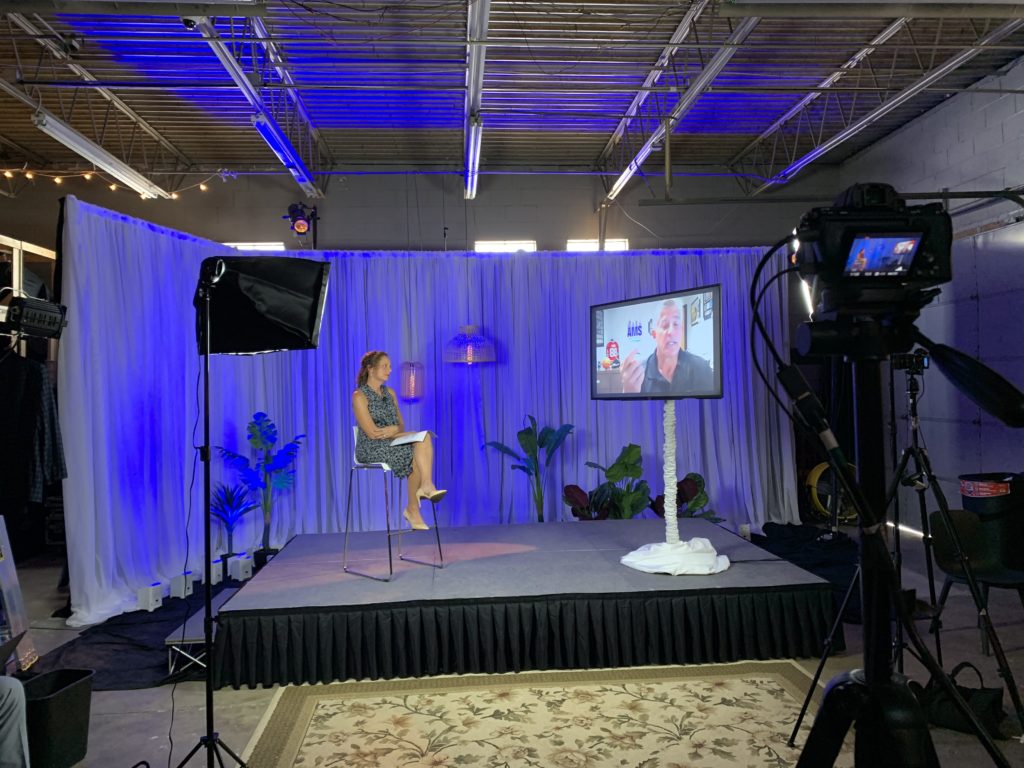
The Hospitality & Tourism Summit is coming at you completely online for its 19th annual year! So, what does that mean? How can a one-day trade show full of tangible experiences pivot to an online experience?
Ateema Media & Marketing, the producers of the summit, have worked hard over the last several months of quarantine to re-imagine the next best alternative. Dubbing this new format as the Hospitality & Tourism Summit Online, all attendees will have the ability to log on and log off at their leisure throughout the week.
The goal for the Hospitality & Tourism Summit is to bring together all industry friends after months of disconnect. The week is built for everyone to pick and choose their own pathway/schedule based on their interests, prior commitments, etc. Ateema has made this "pick and choose" format possible as they will be uploading the recordings of all of the webinars after they are presented live for attendees to watch on-demand. As well, attendees will have access to the trade show floor until next year's summit. They want all attendees to maximize their attendance but also be strategic with the programming you choose to attend live, because you can!
Keep on reading for some common misconceptions about the Hospitality & Tourism Summit Online and how you work around them:
Common Misconception #1: That you have to be online the entire week.
You do not! You can log on and log off based on what is on your personal agenda is each day. It is recommended that you choose a couple of opportunities to attend live each day. The summit has programming that is as short as 45 minutes. Even the longest sessions don't exceed 90 minutes.
Common Misconception #2: If you don't attend everything live, you won't be getting your ticket's worth.
So wrong! All educational sessions will be recorded and placed online for you to view at a later time that works better for you. The trade show floor will be live until April of 2021 so you can go back in at any time and keep browsing all of the exhibitor booths.
Common Misconception #3: Virtual networking is boring and awkward.
Not anymore! The Hospitality & Tourism Summit virtual networking events will be using a lifelike and user-friendly networking software that requires no prior setup on your part. Simply, click a link to enter the networking rooms, "walk-up" to any table, and join the conversation. If you aren't into the conversation or want to find some new people to talk to, leave the conversation just as easily! Live entertainment will also be provided during networking events.
Common Misconception #4: I am furloughed/out of work right now so this won't bring me value.
Switch your mindset! This is the PERFECT time for you to get involved if you are not currently working. At a time when many people in our industry are looking for solutions, trends, timely topics, and predictions for the future, you can say you were a part of those conversations! This is the time to invest in yourself.
Top 6 Tips for Adding Value

Call it a blessing in disguise but, meeting and event planners have gotten to use their creative side when hosting virtual programs. This has mainly come in the form of video conference systems like Zoom, Microsoft Meetings, Skype, and more. While a virtual event seems pretty straight forward, transferring a sponsor’s or attendee’s benefits to a virtual platform is maybe not-so-straight forward. In this article, we are going to give you our best tips for adding value to your stakeholders, a lot of which are from our very own Virtual Planner Master Class. This Master Class brought together some of the brightest minds in meeting and event planning to help discuss these issues and come up with some amazing solutions.Â
- Classes and tutorials: Online classes and tutorials offer great sponsorship opportunities and real value to event attendees. Things like cocktail mixing classes, cooking classes, or craft classes will allow your event to be more relaxed and provide real benefits to participants.Â
- Digital sponsor ad placement: While banners and physical sponsorship apparel may seem longer lasting attendees’ minds, online banners can still make a huge impression during webinars and virtual events. Staying as a static or changing montage of banners, these can bring in more value to sponsors and your event.Â
- Sponsor entertainment breaks: Many more online meetings and events have begun to utilize breaks in order to give attendees a chance to stretch their legs and grab another cup of coffee. During the break, you could host a small concert or another unique form of entertainment that could feature sponsors’ products and services. Or, simply have a screen with sponsor logo exposure that is displayed during the break with background music. This is an easy and fun way to build value around virtual events.Â
- Educational opportunities: A great way to retain sponsorship value in an event is simply by educating attendees through quick company overviews and how they relate to the topic at hand. Tying in a sponsor to your event’s overall theme or mission would allow them to stay even more relevant in the minds of your audience.
- Integrated chat features: Specialized chat room features during, in between, or after presentations can allow your event attendees to get more involved and actively participate with other members. This doesn’t only make meetings more fun, but it also builds a level of trust and participation among people who may be more apprehensive to network from behind a computer screen. Sponsors could also be added to this feature to bring in more value.Â
- Online games centered around rewards : Another great way to spend an online break or happy hour is to host games like trivia or team-building exercises. These will be sure to get everyone to relax more and increase participation among attendees. Sponsors could send out prizes to winners or create questions that are centered around their brands.Â
Written By: Colin Jay
Make Your Virtual Meeting or Event More Desirable
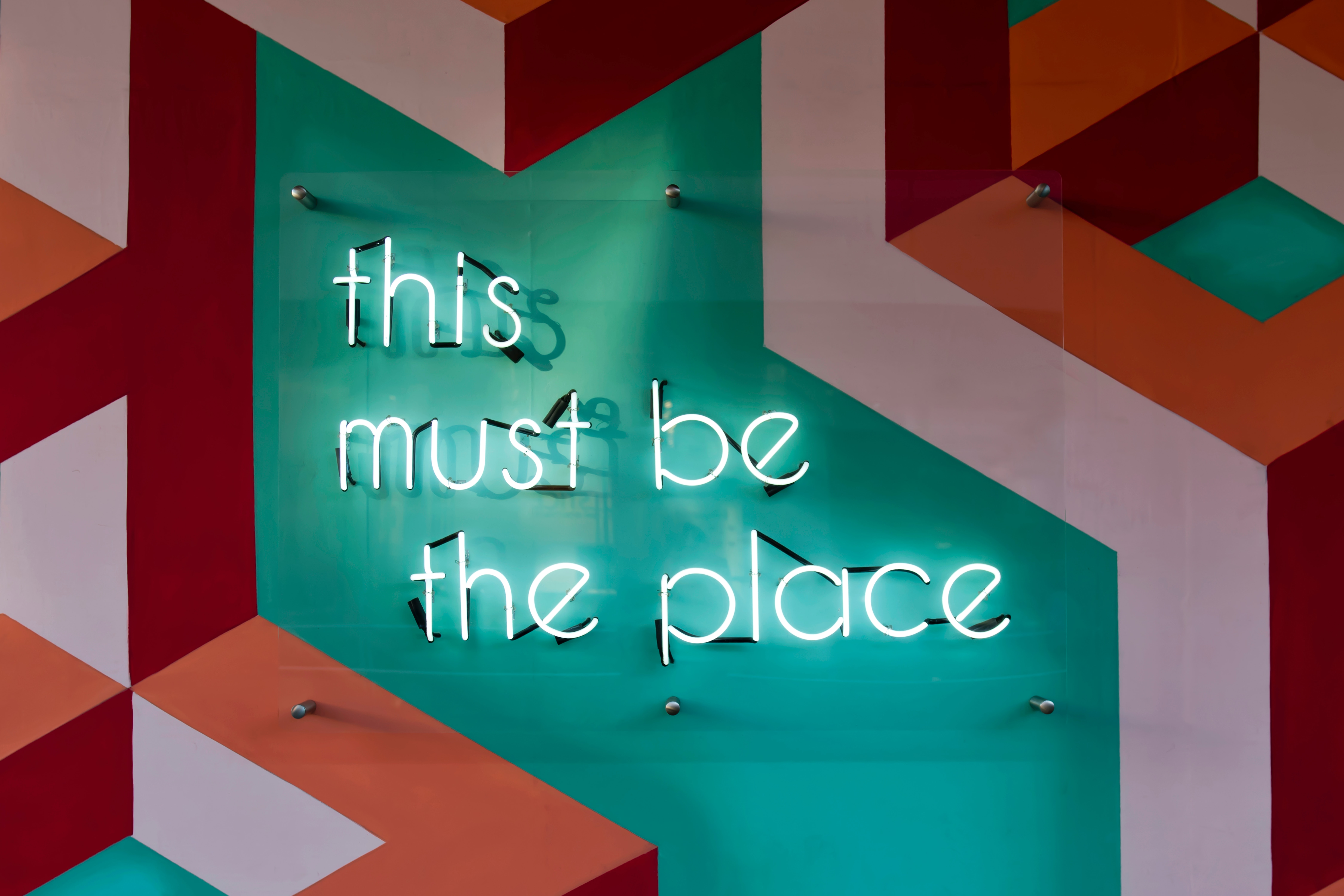
By now, anyone would be shocked to hear that someone has never attended a virtual meeting or event. But, we might not be so shocked to hear that “it was just ok†or “that could’ve been said in an emailâ€. We are finding that after months of moving events online, some are struggling to find ways to keep their content fresh and provide decent value to the attendees. It may require some out-of-the-norm thinking, but with proper use of technology and incorporation of quality education, a desirable and successful outcome is possible.Â
Technology is more important now than ever for hosting engaging meetings and events. However, we are finding that even the best of the best blue light blocking glasses can’t prevent “screen exhaustion†and “zoom fatigueâ€. It can be challenging to even know where to start when beginning to plan, so start with an informative and user-friendly event website. The event website should be a resource for potential attendees to learn about the event and register. The website can include the event itinerary and communicate to potential participants the value in attending the virtual event.Â
Pro tip for standing out: Be concise with the information on your website registration page. Someone should be able to figure out if this is a virtual meeting or event they want to attend within the first 60 seconds on your page. If your website is top notch, people will associate that with how your event will go.
Gaining participant interest and registration is an important first step, but keeping participants engaged with the use of technology once the event starts is even more important. So, sure the event team knows how to effectively use the technology. And if they don’t, hire someone! Nobody wants to join a virtual event and have to deal with the infamous “technical difficultiesâ€.
Pro tip for standing out: Make sure that there is powerful WiFi wherever the meeting, event, or presenter is streaming from. Although it would be nice in our personal lives to have a mute button, you don’t want a presenter’s mouth moving with the words lagging 2 seconds behind.
There are many new tools to provide a more “real†virtual experience. One of these being virtual reality. While this concept seems new to many of us, taking advantage of VR is not as difficult as it may seem. Give your attendees a tour of a museum or gamify a trade show floor using software. Take VR to another level by having event attendees create an avatar for themself that can walk around an event venue virtually to network or choose different breakout sessions they may be interested in.
Pro tip for standing out: Research new softwares or ways of live streaming. A screen share, although effective, is not always exciting anymore.
Since moving meetings and events online, it is a lot easier for an attendee to get up and walk away, or start working on something else. The point of your virtual meeting or event should not be to provide background noise to someone’s lunch hour. If that was true, our industry would be trending on Spotify Podcasts. Ultimately, you want engaged attendees that are learning something. If they feel as if they didn’t gain valuable knowledge, they will likely not be interested in attending future events with you. Try partnering with an educational institution or a highly valuable principal in the industry to add credibility to the event.
Pro tip for standing out: Not only does your educational speaker affect the quality of the event, but also the uniqueness of the content they share. People want solutions without having to read between the lines. Find someone who is able to speak on a different angle than attendees have maybe heard before.
Written By: Kelly Pawlak
Three Ways to Host Safe Events Now
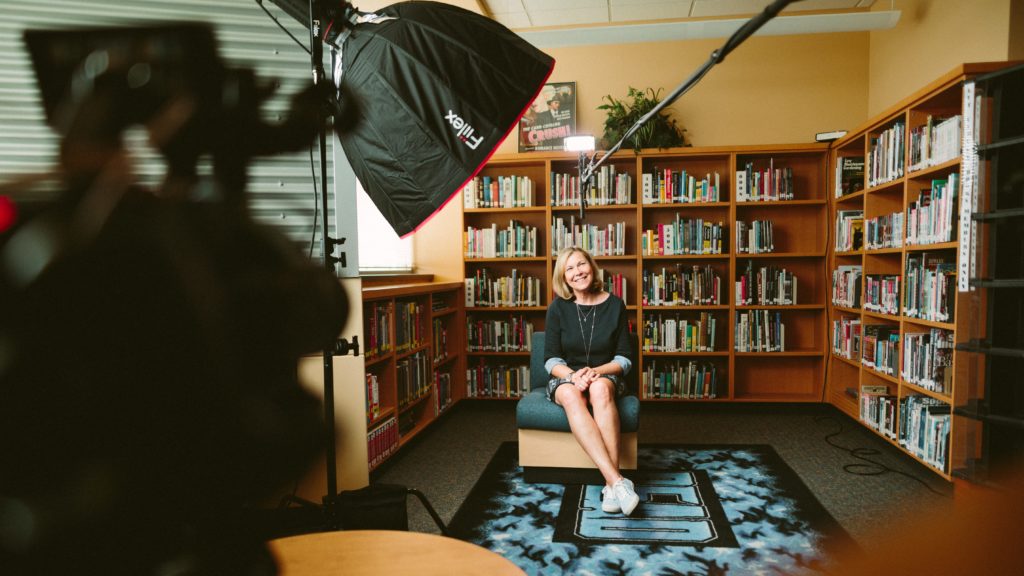
The events world has been shaken up for quite a bit now. As the industry progresses through the phases of reopening, there has been one common denominator: safety first...and that will likely be the new standard. Through remaining connected with our industry peers, we found that what almost everyone wants to know is “Of all the work-arounds due to COVID-19, which ones are here to stay forever?â€. Until the future of events unravels, here are three ways you can host an event now without compromising the safety of your stakeholders.
1. Try out a hybrid event
While virtual events aren’t going away anytime soon, a hybrid event might be the next stepping stone to ease people back into in-person events. Cannonballing into the pool of pre-COVID events might not set you up for success. Instead, you may find that doing a hybrid event, partially live and partially virtual, is a great way to dip your toes in. For instance, try having your presenter(s) broadcast live at a venue, yet keep attendee participation virtual.
At Virtual Planner Master Class, broadcasted live from The Old Post Office, the Ateema team hosted their event at a venue, just as one would for an in-person event. The main difference was that the presenters were speaking to the attendees through a room equipped with A/V broadcasting capabilities and their outfits included a mask as the finishing touch instead of a name badge. What didn’t change was the wow factor. Jamie Sowski, Marketing & Events Manager for The Old Post Office, was able to have a video production team pre-record their gorgeous and historic event space, play that video during the broadcast, and do a live voice-over just as if she was actually walking potential clients through the venue.
2. Think unconventionally when working with vendors
Okay, so you may not want to have a medieval-times-feast-style meal for safety reasons. However, that doesn’t mean you have to rule out catering. Whether your event is hybrid or strictly online, catering companies have plenty of creative ways for your attendees to indulge while also keeping them safe.
For virtual events, consider having boxed meals or DIY cooking kits delivered to attendees’ homes. This way, you are bringing the “IRL†factor while eliminating the potential for others (not equipped with PPE and lawfully required to meet sanitization standards) to come in contact with the food. To turn it into a hybrid event, consider broadcasting from a kitchen or bar with a live demo for the attendees to follow along with their goodie boxes delivered prior to the event.
Blue Plate Catering hosted a happy hour after Virtual Planner Master Class where they showcased their deliverable, seasonal offerings, and encouraged attendees to GYOB (grab your own beverage) while watching a mixologist demo their “sealed-with-safety†margaritas.
3. Design strategically for maximum comfort
In addition to the type of hybrid event we mentioned earlier, there are other ways to host a hybrid event. One of those ways is to allow a limited number of attendees to experience the event live with the event host and presenter(s). But before you go crazy with sending out these VIP invites, you need to envision the event design and event flow for maximum safety and respectively, maximum comfort.
So, how can you grab a venue that permits the ability to socially distance with ease? An answer to this question is outdoor events...bring your guests outside to the openness and fresh air. Or, opt for a large venue. Long gone are the days when a venue says “we've squeezed 100 people in a 500-square-foot room beforeâ€. Rooms with spacious floor plans are going to be better received by skeptical guests. It creates a feeling that their personal space is not threatened.
Also, give every guest a way to display their level of comfortability without the awkward do-we-hug-or-do-I-just-wave-hello moment. Support a local printer and create stickers with comical sayings like “Can’t Touch This†or “Free High Fivesâ€. When you create stickers for your attendees, don’t forget stickers for the floor...yes, you read that correctly. Having reminders on the floor that show people which way to walk and how far apart to stand is a great way to plan safe event flow and spatial comfort.
Written By: Emma McVady
5 Trends To Think About While Pivoting Back to Live Events
As companies try to resume conducting business under the new normal, it will be a learning curve for all including event planners, hosts, vendors, venues, and attendees. Adjusting to the new norm post-COVID-19, those that are able to be flexible, adaptable and can pivot during these challenging times could be the most successful!  Keeping an open mind to new ways of hosting events which includes human interaction can be very advantageous as the industry plans for live events. Here’s our projections for what trends we might see when we start meeting in person again...
Never Enough Precaution
Besides checking your typical details with vendors, suppliers, and the venue, safety and security processes will now be incorporated. These safety protocols should be communicated to your guests to ensure them that their health and safety are at the forefront. It is now standard protocol to have a COVID-19 event checklist that includes temperature checking of employees and guests, in addition to requiring all to wear a face covering. There will be a dramatic difference with how everyone interfaces with each other as well. Long gone are the days where greeters are handing out materials such as maps and agendas as events will establish more self-service features for their participants. In addition, hand sanitizer will be more readily available and very much appreciated. Guests might be limited to bringing their belongings as ensuring the safety for both your guests and employees will go a long way. 
Innovative Food Options
It is important that participants feel all safety precautions were considered when it comes to the food being served at the events. As part of taking precautionary measures, buffets may not be a popular option to avoid serving utensils having multiple touches and to avoid people standing in lines. But don’t worry, planners are looking at creative meal options. Boxed lunches or pre-packed grab and go individual meals will be offered as well as seated meals. Planners will also be thinking outside of the box such as leveraging favorite food trucks or catering from your popular restaurants with carry out style options to still make it an enjoyable event. Although seating may be more restricted in numbers at a table, who says you can’t have a great experience with a smaller intimate group which may encourage better networking and connections?
Behind-the-Scenes Workers Now in the Spotlight
Pre-COVID 19, it was all about seamlessly transitioning the events with flipping the rooms quickly to avoid any type of event distractions. Post COVID-19 attendees might want the staff to be more visible. Seeing them frequently wiping down high touched spaces and continuous cleaning will now be more than welcomed. As well, I’m sure attendees won’t mind the cleaning crew to spend a little extra time in between room flips.
Empty Rooms a Good Thing Now?
In order for participants to feel comfortable to be in the same room with others while allowing the appropriate social distance, it is now acceptable and expected that rooms are not filled to capacity to reassure their guests. Brainstorming possible event room layouts with bigger rooms for less people and to how to space out the furniture will be key. Foot traffic directions that include warning signs that show “high traffic†or “high touch areas†will be part of the event set up too. Lastly, event planners will need to consider the staff’s ability to wipe down as frequently as possible based on venue layout.
Hybrid! Hybrid! Hybrid!
As we adjust to our new norm, hybrid events should be considered as an option. Hybrid events combine live people with virtual attendees and with budgets that may be more limited to hosting smaller groups this still allows for that personal connection. Something else to consider is combining live presentations and entertainment broadcasted from different rooms as that will help avoid having too many people in one room at a time. An additional benefit to hosting hybrid events, is the ability to be more flexible because the resources that you will be depending on will be more limited such as security, staff, catering, PPE, cleaning supplies, etc. Hybrid is a great alternative option for those who may still fear gathering with other people but also an opportunity to keep your event participation rate high.
4 Ways to Inspire Exhibitors to Adopt New Technology

The "If it ain't broke" mentality sounds good if we're talking about a bicycle or a toaster. But when we're talking about business tech, people in every industry have a natural reluctance that blinds us to possibility. Yes, it's working fine, but it could be working better. When we introduce new tech, we usually get a big surge up front from the early adopters, and then it tapers right off. So how do you hook those people in the middle and keep the bell curve going? Here are the markings of successful tech adoption at events:
1. The Tech Serves The Attendees
You know your market, you know what your attendees are all about. Technology that helps them meet their goals will be welcome, while tech that does not will be regarded as mere clutter. Tech geeks love new tech for new tech's sake, but most business professionals will allot their time and attention only to that which has a clear, practical purpose for them in their work. If you want your attendees to use the technology, consider these questions: What problem does this solve? What task does it make easier? You'll need to consider these questions beforehand, because these are the questions that attendees are going to want answered.
2. The Event Is Structured To Encourage Engagement
You can't just drop new tech onto a crowded event floor and expect people to be excited. The event has to be orchestrated so as to encourage engagement with the new technology. Integrating the new tech directly into the event will help attendees to understand precisely what makes it useful. Distributing an app for the event instead of brochures and physical maps, for instance, will go a long way towards pushing engagement. Wherever you can incorporate the tech, incorporate the tech.
3. You Can Count On The Wi-Fi
No matter how good the tech rollout is on every other front, if people have trouble accessing wi-fi on the event floor, it will all be for naught. This can be the number one barrier to engagement. You may have a tech-savvy crowd eager to engage, tech that's intuitive and easy to pick up, but if people simply can't connect then what good is any of that?
4. Attendees Have Been Primed
Getting people excited for the new tech that's going to be coming to the event through an email campaign can be very helpful. Even better: You can get people acquainted with the tech before they see it firsthand. This way you can save time on in-person tutorials, since many of your attendees will already have grasped the basics from the email campaign. This can drive enthusiasm for the tech and make it seem less alien on first encounter.
Even in tech-heavy fields, there's always going to be a reluctance to embrace something totally new. This can be a problem at events, where you need everyone to get up to speed quick. But by following these guidelines, you should be able to maintain a higher rate of success in adoption to the new apps and gadgets.
Original post on Expo Pass.


